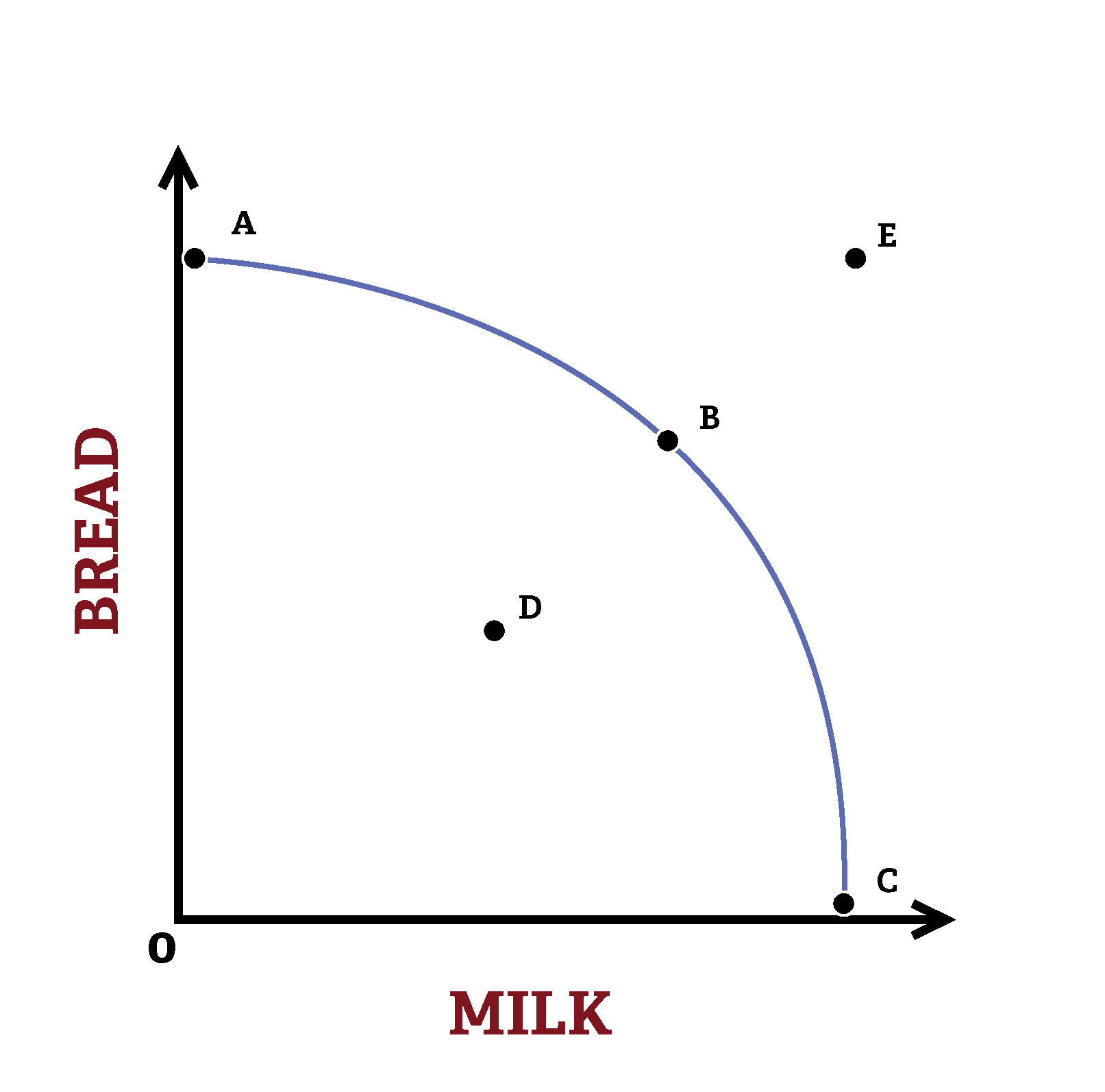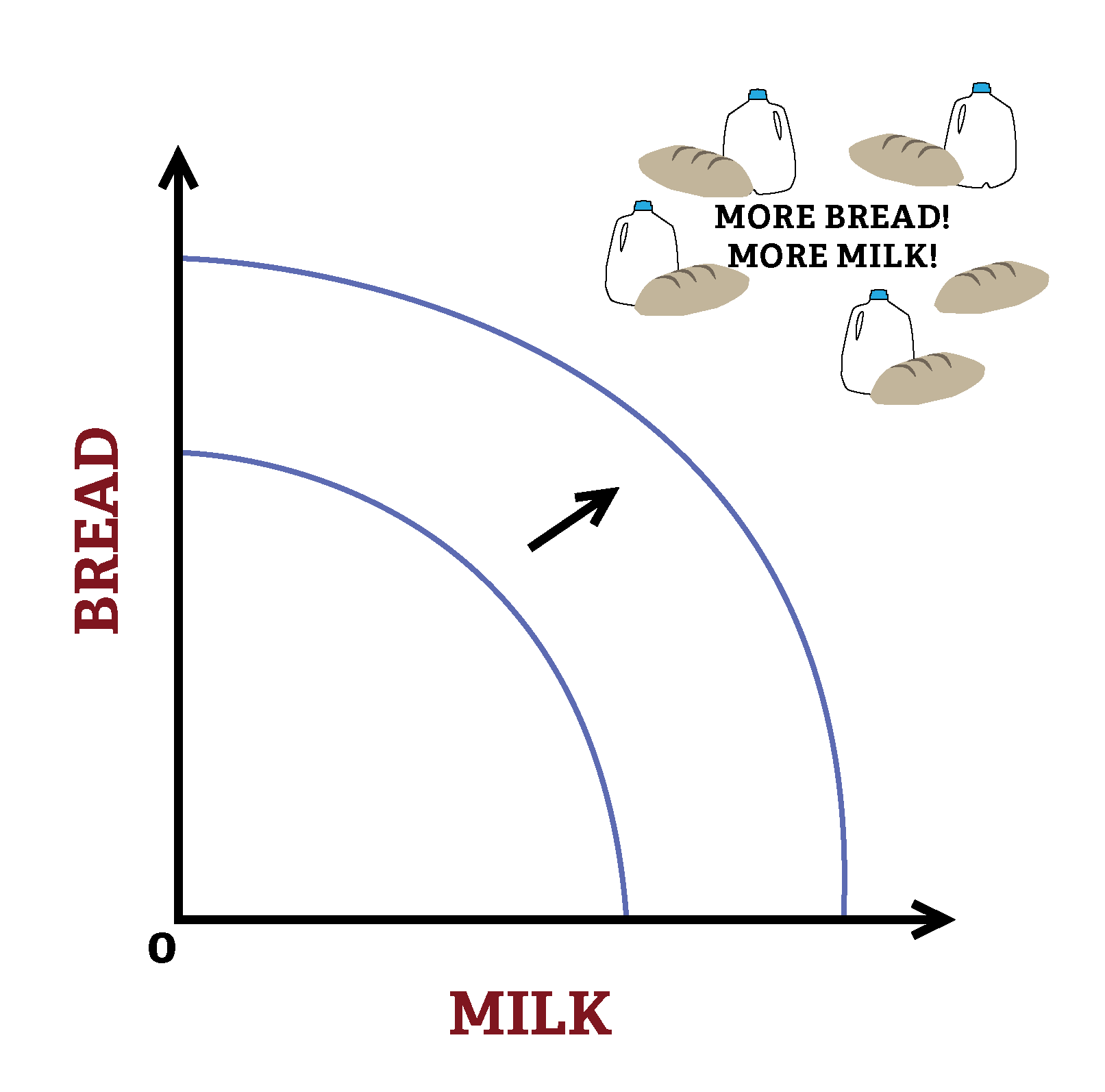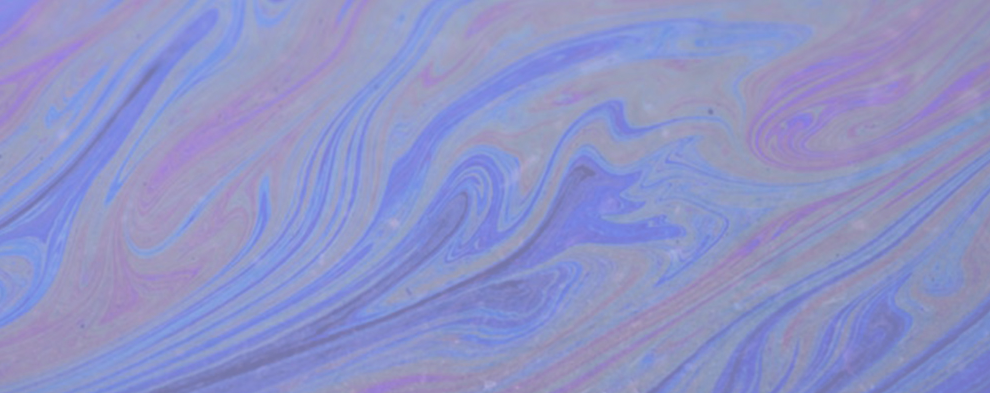Whenever a company, factory, or even country decides to produce something, there is only so much they can make. A finite amount of capital (factories, production equipment, etc) and laborers exist, and they limit the possible amount of production. The production-possibility frontier, or PPF, is a graphical way of showing trade-offs in production choices between 2 items.
If the United States decided tomorrow to produce as many loaves of bread as possible, there would be a limit to how many loaves were made. Only a certain amount of ovens, flour, and people exist at the present time. Say that it is decided we will produce milk as well. Only a certain amount of workers exist in the labor force, and with half making milk and half making bread, we can only produce a finite amount. A PPF would represent how much of either item we can produce:

In this way, a PPF represents the trade-offs that are inherent to production. The PPF assumes that labor supply, production facilities, and more are all fixed numbers. In this sense the PPF shows short term production possibilities. While production can always be increased, it takes a long time to build new factories, find new workers, and more. So, the PPF shows what the current-state of production would look like.
Imagining a PPF for a whole country can be hard, because it seems awfully simplistic. PPFs can be useful for companies or even individual factories - they provide a nice way of looking at all the options one has for production.
A PPF can also indicate if production is efficient, as the line of the PPF consists of all the possible efficient production points (i.e., all possible resources are being used and utilized, production is maxed out). Look below at point B - America is using all the possible resources to make as much bread and milk as possible. Point A and C are efficient, too, as all the resources in the economy are being used to produce bread or milk. In fact, any point along the PPF line will be efficient! However, point D is inefficient, as America could be making more bread and milk. Point E would be a great goal, but is impossible to reach with existing resources. That doesn't mean we can reach point E one day, though. If the economy grows through changes like new technology, better management and additional workers the PPF shifts outward, and we are now able to make more things!
PPFs are not all curved outward, either! The shape can change depending on characteristics of the economy it represents. A linear PPF indicates that the goods can be interchangeably produced. For example, a factory equipped with ovens and other baking equipment could easily shift between making bread one minute and cookies the next! They don't have to buy separate equipment for these processes or hire different workers. A factory could not shift between making bread and making milk that easily, so it will be a bigger trade-off for them. Changing from producing all bread to half bread and half milk would cost them a lot more than changing to half bread and half cookies.
A PPF curved inward indicates "economies of scale". This means that the more of a good that is produced, the less it costs to produce each additional unit. This would apply for something like bulk production, where producing 1 unit will cost a minimum of $1000 to pay for workers and equipment, producing 2 would cost $1010, 3 would cost $1020, and so on. In this way, as more is produced the cost of each unit declines. Eventually, the decline in individual cost will become less dramatic and flatten out.
In Short:
The PPF is a graph that can show trade-offs in production. It is a very flexible framework that can be applied to various industries and economic areas, and provides a visual way to represent production choices. PPFs can be used to represent a wide variety of economic concepts, including opportunity cost (trade-offs), efficiency in production, efficiency in allocation, economies of scale (diminishing costs of production), and resource scarcity.
Popular mobile payments app Venmo enjoys the benefits of behavioral economics biases, causing users to feel less pain from spending money. Learn how it works, and how businesses can capture the "Venmo effect".
Deep-dive into the increasingly personal way we interact with brands, fueled by Snapchat and Instagram.
Some musings on the benefits of the changing cultural consumption landscape (including the shift to streaming of music and TV).
Females are prescribed psychiatric drugs at much higher rates than men. Females also tend to be more emotional (wide generalization). Processing emotions takes time, and time spent on emotional work is time NOT spent generating revenue. Ultimately, the trend of medicating female emotion (and emotion in general) is a money-driven one.
The Internet of Things (IoT) is the future of technology, but also represents some interesting economic phenomena not-so-frequently seen.
We all hate surge pricing, but it's a great way for Uber and its drivers to capture more value. What if GrubHub, Starbucks, etc. charged customers more during peak hours in order to pay service workers better? Could we ever break the cycle of reliance on cheap labor?
Price discrimination is a way that companies can make more money by understanding how much different consumers will pay for the same good. Here's how it works.
What's the economic explanation behind the rise of the term "basic"? Is this a new phenomenon, or merely a quality of human nature evident due to economic and technical changes?
Would you pay $35 for a Raspberry Pi? No, not the food, it's a miniature computer! This device can be revolutionary for the 75 million Americans without internet access.
Do you ever forget the difference between nominal and real? Do you wonder why financiers analyze Yellen's words like a text from a crush? If so, this is the article for you!
When fruit flies, it fails. Industrial agricultural practices have brought us berries in January, but at the cost of quality. Read about why harvesting heirloom varieties is important for taste, small farmers, and the environment.
It used to be that the strongest hunter had the most value in society. Today, the nerdy ideas man has the most worth. What happened?
Innovation is cyclical and inspired by other innovation. For example, this article was inspired by my purchase of innovative new ice cube trays. Read about how product variety is created, and how it can be a bad thing.
You may hear the terms horizontal and vertical integration tossed around in business (Businesspeople love fancy strategy terms). Learn how Standard Oil used integration to become a monopoly and how one might benefit from integration today.
Will a big engagement ring buy you happiness? What about donating blood? How do you properly motivate someone? If you are looking for a job, is city size a factor? Why are smartphones important for the poor to have? All this and more.
America is in trouble if the cost of Third World labor increases. As has been the tradition for all of human history, our economic success depends on the accessibility cheap and near-slave labor. How can we grow when this ends?
Some would claim that it is human nature to capitalize upon opportunities. Arbitrage was born of this human urge to take advantage of money-making opportunities.
Efficient appliances seem like a great way to reduce our energy use, right? Wrong - in the long run, they end up causing massive increases in energy use due to cost reductions.
"Run out of oil? Never!"
In all likelihood, this won't transpire, but if you aren't familiar with the idea of peak oil (or like to deny it), answer all your questions here.
Most people could tell you that oil and energy is critical to our economy and planet. In fact, energy is the foundation of all growth, but it isn't included in our economic models. Here's why the discipline of economics needs to be re-organized.
This edition of Deciphering Data brings you the answers to all these pressing questions and more:
- At what time of year do most break-ups happen?
- Why are tiger-moms a thing in the US and China?
- How do different people around the world think success happens?
The rise of American affluence gave us the luxury of choice and ability to be picky about what we like. Combined with newly formed marketing and advertising industries, consumer preferences developed that made perfect substitutes an economic unicorn. (If you don't know what a perfect substitute is, no worries, read on!)
Indifference curves are not graphs of who cares less, rather, they show different combinations of goods that can give a person a certain level of utility, or well-being.
Do middleman apps make our lives better? What about the lives of their employees? Do Uber-like services improve consumer welfare? How do recessions affect birth rates? Why does the US have relatively high infant mortality?
Find the answers to all these questions and more.
Does this man look like he is substituting or complementing these apples? Trick question: apples are inanimate, and can't be complimented.
The best data visualizations from around the web. Learn about online dating, music tastes, political preferences, violence, and earthquakes.
Did you know that higher gas prices might be better for us all? Industrialism is great, but creates negative externalities, such as pollution. Pigovian taxes reduce negative externalities and aim to also reduce distortionary taxes, like income tax. Win-win!































Money represents a social agreement, which has implications for how we value wealthy people. Bitcoin replaces the need for this social agreement with technology, and in doing so challenges the values we ascribe to wealth.